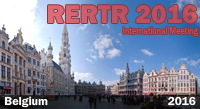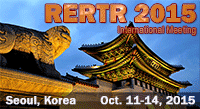Abstracts and Available Papers Presented at the
2003 International RERTR Meeting
STATUS AND PROGRESS OF THE RERTR PROGRAM IN THE YEAR 2003
Armando Travelli
Argonne National
Laboratory
Argonne, Illinois,
USA
ABSTRACT
One of the most important events affecting the RERTR program during the past year was the decision by the U.S. Department of Energy to request the U.S. Congress to significantly increase RERTR program funding. This decision was prompted, at least in part, by the terrible events of September 11, 2001, and by a high-level U.S./Russian Joint Expert Group recommendation to immediately accelerate RERTR program activities in both countries, with the goal of converting all the world’s research reactors to low-enriched fuel at the earliest possible time, and including both Soviet-designed and United States-designed research reactors.
The U.S. Congress is expected to approve this request very soon, and the RERTR program has prepared itself well for the intense activities that the “Accelerated RERTR Program” will require.
Promising results have been obtained in the development of a fabrication process for monolithic LEU U-Mo fuel. Most existing and future research reactors could be converted to LEU with this fuel, which has a uranium density between 15.4 and 16.4 g/cm3 and yielded promising irradiation results in 2002. The most promising method hinges on producing the monolithic meat by cold-rolling a thin ingot produced by casting. The aluminum clad and the meat are bonded by friction stir welding and the cladding surface is finished by a light cold roll. This method can be applied to the production of miniplates and appears to be extendable to the production of full-size plates, possibly with intermediate anneals. Other methods planned for investigation include high temperature bonding and hot isostatic pressing.
The progress achieved within the Russian RERTR program, both for the traditional tube-type elements and for the new “universal” LEU U-Mo pin-type elements, promises to enable soon the conversion of many Russian-designed research and test reactors. Irradiation testing of both fuel types with LEU U-Mo dispersion fuels has begun. Detailed studies are in progress to define the feasibility of converting each Russian-designed research and test reactor to either fuel type.
The plan for the Accelerated RERTR Program is structured to achieve LEU conversion of all HEU research reactors supplied by the United States and Russia during the next nine years. This effort will address, in addition to the fuel development and qualification, the analyses and performance/economic/safety evaluations needed to implement the conversions.
In combination with this over-arching goal, the RERTR program plans to achieve at the earliest possible date qualification of LEU U-Mo dispersion fuels with uranium densities of 6 g/cm3 and 7 g/cm3. Reactors currently using or planning to use LEU silicide fuel will rely on this fuel after termination of the FRRSNFA program, because it is acceptable to COGEMA for reprocessing. Qualification of LEU U-Mo dispersion fuels has suffered some unavoidable delays but, to accelerate it as much as possible, the RERTR program, the French CEA, and the Australian ANSTO have agreed to jointly pursue a two-element qualification test of LEU U-Mo dispersion fuel with uranium density of 7.0 g/cm3 to be performed in the Osiris reactor during 2004.
The RERTR program also intends to eliminate all obstacles to the utilization of LEU in targets for isotope production, so that this important function can be performed without the need for weapons-grade materials.
All of us, working together as we have for many years, can ensure that all these goals will be achieved. By promoting the efficiency and safety of research reactors while eliminating the traffic in weapons-grade uranium, we can prevent the possibility that some of this material might fall in the wrong hands. Few causes can be more deserving of our joint efforts.
![]() PDF version available
PDF version available
DOWNLOAD full paper in PDF format.
Contact:
Dr.
Armando Travelli
RERTR Program
Nuclear Engineering – 362
Argonne National Laboratory
9700 South Cass Avenue
Argonne, IL 60439
Phone: (630) 252-63639
Fax: (630) 252-5161
![]()




